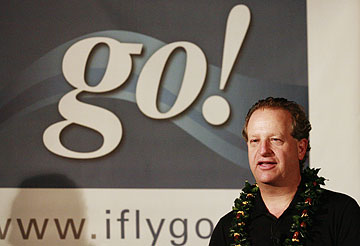
CINDY ELLEN RUSSELL / CRUSSELL@STARBULLETIN.COM
Jonathan Ornstein, chairman and CEO of Mesa Air Group, spoke at yesterday's news conference announcing new go! interisland flights.
|
|
New airline go! takes wing this summer
The interisle carrier begins booking seats, with prices starting at $39
Mesa Air Group Inc.'s much-anticipated expansion into Hawaii as an interisland carrier will be a "go!" as of June 9, with one-way fares starting at $39.
The company unveiled its to-the-point name and logo go! yesterday and began taking reservations. The carrier is expected to change Hawaii's interisland air travel market by providing cost-weary consumers with more choice, and has already prompted an industry fare war.
THE INTERISLAND COMPETITORS
MESA AIR GROUP
Headquarters: Phoenix
Founded: 1982
Service: Beginning June 9, will offer 16 flights a day; beginning June 23, will offer 31 flights a day
Routes: Oahu, Big Island, Maui, Kauai
Planes: Canadair regional jets seating 50, 70 and 86 passengers
ALOHA AIRLINES
Headquarters: Honolulu
Founded: 1946
Service: 100 flights a day
Routes: Honolulu, Hilo, Kona, Kahului, Lihue
Planes: Boeing 737-200 seating 117 passengers
HAWAIIAN AIRLINES
Headquarters: Honolulu
Founded: 1929
Service: 135 flights a day
Routes: Honolulu, Hilo, Kona, Kahului, West Maui, Lihue, Molokai, Lanai
Planes: B-717-200 seating 123 passengers
ISLAND AIR
Headquarters: Honolulu
Founded: 1980
Service: 92 flights a day
Routes: Honolulu, Kahului, West Maui, Molokai, Lanai, Lihue, Hilo, Kona
Planes: Dash-8 seating 37 passengers; one Q400 seating 78 passengers
|
Jonathan Ornstein, chairman and chief executive officer of Mesa Air Group, who was in town yesterday, said he expects to shore up island business by tapping a niche market of Hawaii residents and business people who had cut back on flying between the islands because of prohibitive ticket prices.
"Our goal is to provide local families, friends and business people with a fun, high-quality and low-cost airline for travel between the islands," Ornstein said. The company's $39 fare is an introductory offer, he said, but he expects to deliver lower fares than his competitors.
Wednesday night, Aloha and Hawaiian airlines announced they were lowering fares to $39.
Hawaiian also has sued to delay Mesa from coming here, alleging Mesa used Hawaiian's confidential internal business information in forming its plans.
These fares are the among the lowest offered since Hawaiian and Aloha stopped issuing discount coupons and taking last-minute reservations during their financial struggles and bankruptcies. The presidents of both carriers said customer response to the new fares has been strong.
But with both Hawaiian and Aloha out of bankruptcy only recently, the question remains how long they can hold fares down to compete against Mesa, which would be the state's fourth interisland carrier, joining Aloha, Hawaiian and Island Air.
"It's really hard to believe that we are a four-carrier market -- we've never had four carriers," said David Banmiller, president and chief executive officer of Aloha Airlines.
The entry of another airline into Hawaii's interisland market could be a boon for tourism, said Frank Haas, marketing director for the Hawaii Tourism Authority.
"Because of higher prices, things like one-day tours to the neighbor islands have declined," Haas said. "Hopefully, if we begin seeing more seats and lower fares, some of that activity will come back."
But while tourism officials are always happy to see consumer-friendly pricing, it is important for the interisland airlines to be profitable, he said.
"There's got to be a balance," Haas said.
Mark Dunkerley, president and chief executive officer of Hawaiian Airlines, said his company will hold the $39 fare as long as it takes to meet the competition head-on.
"We are looking forward to the competition," Dunkerley said.
He said he does not know how many carriers can last, but that he is confident Hawaiian will be one of the survivors.
Banmiller said that since emerging from bankruptcy, Aloha's balance sheet and its position in the marketplace have vastly improved.
But he added, "No company, not even Mesa, is going to be able to sustain $39 fares."
Ornstein, who has been eyeing the Hawaii market for more than a decade and considered buying both Hawaiian and Aloha airlines during their reorganizations, said his company has a strong industry network and record of profitability. Mesa is undeterred by the fact that Aloha and Hawaiian previously had to file for bankruptcy, or by the escalating fuel and labor costs that have plagued the entire air industry, he said.
The airline, which has been profitable for 26 of the last 27 quarters, took in about $1.4 billion in revenue last year with profits reaching about $129 million, Ornstein said. The company, which has $300 million in cash, is better capitalized than Aloha and Hawaiian, he said.
Also, cheaper tickets will boost market growth, which has been held back by high prices, Ornstein said.
"The local market has been priced out," he said, "but the local market, especially the business market, is there. If we offer value and good service, I believe that it will come back over time."
Mesa so far has no code-sharing agreements, which allow competing airlines to sell tickets on each others' planes. Ornstein said he envisions reaching code-share pacts with other carriers eventually, as well as expanding go! to other destinations outside of Hawaii.
"Hawaii is a pilot location for us," Ornstein said. "It's less than 2 percent of our business, but strategically it's critical. We think the Hawaii model will work and that we can use it elsewhere."
Although Mesa will be busy carving out space in Hawaii's crowded market, the company is looking at other underserved destinations like China and South America, he said.
"There are 2,000 regional routes in the United States, but China only has 40," Ornstein said. "There's great potential in this market."
In part, he said, that is why Mesa picked the generic logo go!
"We chose the name go! because that's exactly what we think people want: a reliable, quick, no-hassle way to get from point to point across the state," Ornstein said.

